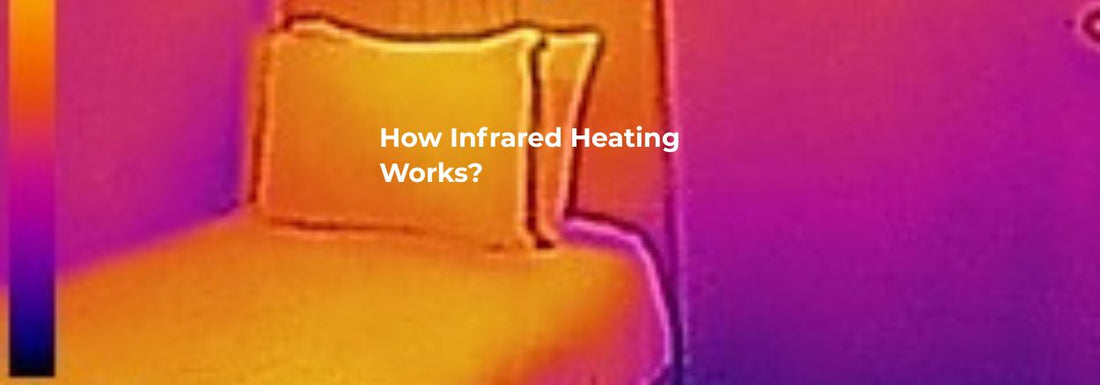
How Infrared Heating Works?
Infrared heating warms people and surfaces directly using radiant energy, delivering natural comfort at lower air temperatures compared to conventional convection systems.
What Is Infrared Heating?
Infrared heating is based on radiant energy — the same type of warmth you feel from sunlight on a cool day. Instead of heating air and circulating it, infrared systems warm people and surfaces directly. Once surfaces absorb that energy, they slowly re-emit heat back into the space, creating stable, lasting comfort.
Modern solutions include slimline infrared panels and discreet infrared heating films installed in ceilings, walls, or floors.
The Science in Simple Terms
Infrared sits just beyond visible red light on the electromagnetic spectrum. It’s commonly divided into:
- Near Infrared (NIR): High intensity; industrial processes and some therapies.
- Mid Infrared (MIR): Medium intensity; used in drying and manufacturing.
- Far Infrared (FIR): Gentle, safe wavelengths ideal for domestic and commercial comfort heating.
FIR is absorbed by the outer layer of walls, floors, furnishings, and skin. These surfaces then act as secondary emitters to maintain an even warmth.
How Infrared Works?
- The heater emits far infrared radiation into the space.
- Energy travels through air and is absorbed by surfaces.
- Those surfaces warm up and re-radiate heat back into the room.
Comfort at lower air temps: Infrared-heated rooms often feel cosy at 18–19 °C vs. 21–22 °C for convection systems. That 3–4 °C gap can reduce energy demand.
Why Infrared Heating Feels Different
Convection warms air. Warm air rises, leaving cooler air at floor level and hotter air near ceilings. Infrared flips the script by warming surfaces (and you) first, so you feel comfortable sooner and more evenly, with less stratification and fewer drafts.
Key Benefits of Infrared Heating
- Energy efficient comfort — Lower thermostat set-points to feel the same warmth.
- Even heat distribution — Surfaces become gentle secondary heat sources.
- Cleaner air — Reduced air circulation means less dust and allergens.
- Low maintenance — No moving parts; long service life.
- Design flexibility — Panels and films suit new builds and retrofits.
Infrared vs. Traditional Heating
| Feature | Infrared Heating | Convection Heating |
|---|---|---|
| Heat transfer | Direct to people & surfaces | Indirect — warms air first |
| Comfort temperature | Feels warm at ~18–19 °C | Often needs 21–22 °C |
| Air quality | Minimal air movement | Can stir dust/allergens |
| Maintenance | Low — no moving parts | Higher — pumps, valves, servicing |
Where Infrared Heating Is Used
- Homes: Living rooms, bedrooms, kitchens, and bathrooms.
- Commercial: Offices, studios, clinics, hospitality spaces.
- Retrofits: Thin panels/films minimise disruption in upgrades.
- Outdoors: Patios and terraces (with appropriate products).
Installation & Controls
For the most even results, ceiling mounting is popular for panels and films. Wall mounting can target specific zones (desks, seating). Smart controls and thermostats rated for infrared loads with room/zone scheduling help reduce waste. Features like open-window detection and occupancy sensing can further improve efficiency.
Sizing & Power Guide
Infrared systems are typically specified by room heat loss and desired comfort level. As a broad guide (not a substitute for a heat-loss calculation):
- Well-insulated spaces: ~50–70 W/m²
- Average insulation: ~70–90 W/m²
- Poor insulation / high ceilings: ~90–120 W/m²
Room geometry, glazing, and occupancy matter. For an accurate plan, request a free sizing consultation.
Environmental Impact
Infrared supports low-carbon living. Because it’s electric, pairing infrared with solar PV and home batteries can significantly reduce grid reliance. Achieving comfort at lower air temperatures also helps cut overall energy use.
Ready to Try Infrared Heating?
Talk to our team about a tailored plan for your home or project — from sizing to installation and smart controls. That’s living reinvented.
Book a Free Consultation | Explore Infrared Heaters
